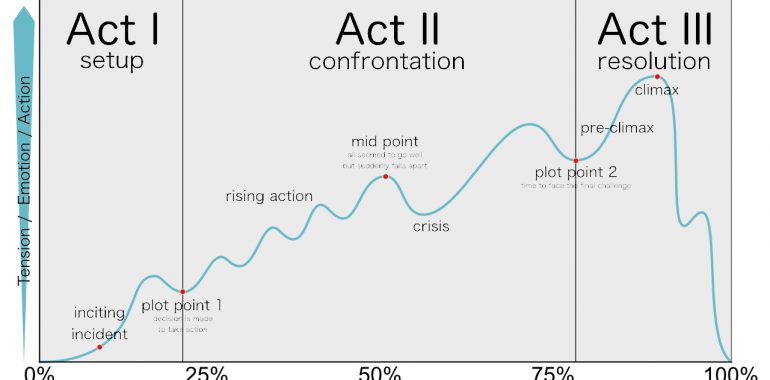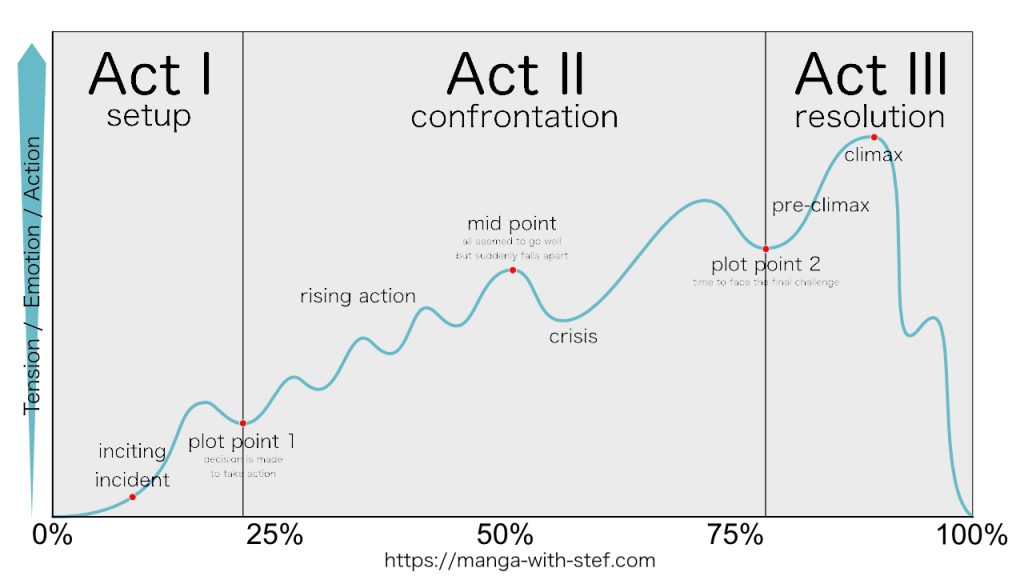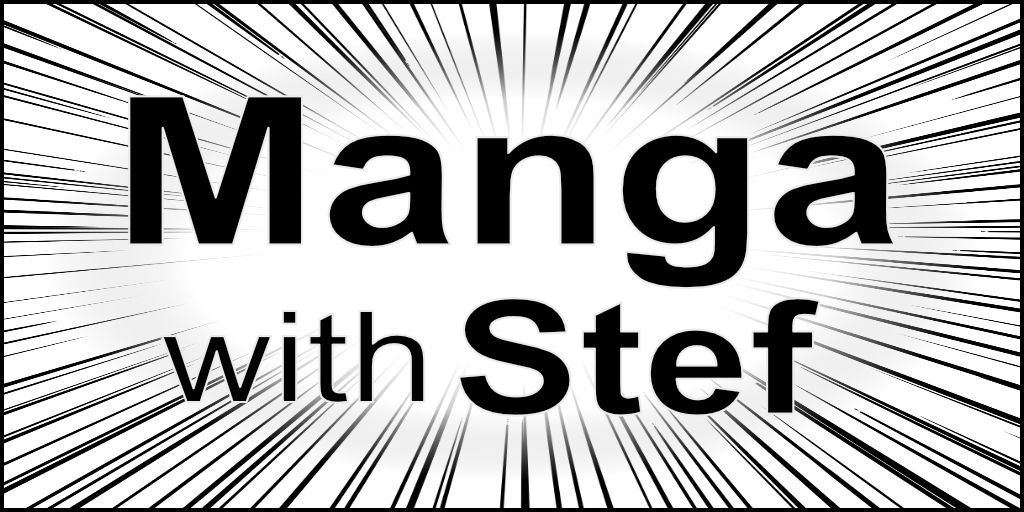Using the 3 Acts Structure in Your Manga Story

Using the 3 Acts Structure in Your Manga Story
Creating an appealing story plot for your manga story can be a difficult and treacherous for someone new to storytelling. This requires you to understand how to drive the readers emotions so that they will be eager to follow your story to its end. The 3 Act Structure is a simple and proven method to building an interesting story plot for your manga.
We will therefore see how you can use this 3 act structure to develop your manga story idea.
The 3 Act Structure
As implied by its name, the 3 Act Structure is composed of 3 acts:
- Setup
- Confrontation / Rising action
- Resolution
The objective of this structure is to gradually build up tension and emotion.
This objective is achieved in three steps:
- Set the character(s) in front of a big challenge.
- Show that the character(s) gradually move(s) toward overcoming that challenge through trials, errors, and small victories, but that there is still some uncertainty as for his/her/their capacity to overcome the challenge.
- Finally, have the character(s) overcome(s) the challenge in a way, or another.

Act 1 – The Setup
Note for sake of simplicity, I will take the example of a single male main character. But this of course applies to any character, or group of characters.
Introduce your main character
First, the setup is where the readers shall discover and come to like your main character.
Stories generally achieve that goal by showing the main character in his everyday life.
This part will also generally show what are some strength, as well as some of the weaknesses, of the main character.
This first part is key because if you can’t make readers like your main character, then they will not care for what could happen to him.
The inciting event
Then, an event (called inciting event, or catalyst) will occur that will put the character in front of a big challenge.
This event can be:
- A problem striking the character or one of his close relations (illness, death, earning a lot of money…),
- A decision taken by the character or one of his close relations (to stop smoking, to travel around the world, to become the king of pirates…).
- Another character asking for the support of the main character (protection from a villain, resolution of a math exercise…).
- An external event or menace (a drought, an earthquake…)
- …
This challenge shall be bigger than what the character is able to handle. It should lead him to fail, but also to decide or force him to have to face it.
This point is called the plot point 1 and marks the end of act 1 and the beginning of act 2.
Summary of act 1
At the end of this first act, readers should be caring for your main character. Thy should be wondering if he will be capable of reaching his objective, and wonder how he will do it as well.
Example:
- SonGoku is having a peaceful life with his wife and son. But one day he senses an unknown energy and encounters a new enemy coming out of nowhere that defeats him. That enemy is menacing to kill all humans and Goku decides he must prevent him from doing so.
Act 2 – Confrontation / Rising action
Rising tension
In the second act the hero will start moving toward his new objective. He might learn new skills or things, find objects, encounter new people…
This is at that stage that the tension is building up. Your readers will see your main character doing efforts. He will be failing at first, or progressing with difficulty. But slowly, he should be improving.
In the middle of act 2 (called midpoint) the hero will encounter a major success.
Introducing uncertainty
But after that success the story will tip over. The main character shall encounter a major difficulty, letting him at his lowest, full of doubts. The reader shall be wondering if he will finally be able to reach his objective…
The final plan
This is where your hero will take a new decision that will set him back on track. This can be your main character finally understanding the true nature of things. Or accepting fate. Or finally approaching the challenge through a different angle.
Whatever the track, the decision is made to finally confront that initial challenge.
This point is called plot point 2 and marks the end of act 2 and the beginning of act 3.
Summary of act 2
Through act 2, your character shall have gone through a lot of ups and down. His capacity of facing the challenge shall have increased, but some doubt shall still remain. Your readers shall be excited, they have seen your character raising in skills and understanding. And yet they should still be wondering if he will be able to make it now that he steps into the arena to face the challenge.
Example:
- SonGoku trains hard with his friends and they finally learn a new technique. But as they fight the enemy this one appears to be stronger than expected and their new technique, lacking stability, seems inefficient and they end up taking big injuries. But Goku suddenly has an idea…
Act 3 – Resolution
Make it epic
In this last act, the hero will make his last and desperate attempt to overcome the challenge. This point is called climax and is the point of upmost tension.
At this moment, your readers should be excited and hold their breath. They should be eager to see the outcome of your main character’s actions. They must be excited to discover that final trick your hero might have found to win…
This phase should look epic.
Your hero should seem on par with the challenge. There might be some downs, but the chance shall still remain that your hero will succeed. This should feel like a race where your character and his opponent are struggling to take the lead. Like the last minutes of a tournament match where the readers favourite team is struggling to score the winning goal.
Pitfalls to avoid
Whatever will be the outcome of that final challenge, you mustn’t show your main character being too weak. He should not look desperate all along the confrontation.
If this happens, then your readers will doubt and the tension and excitement will taper off.
In such case, even a last minute twist will not be able to recover the tension. This will look like more to some magic trick that flipped over the situation, and not so much as the result of the hard work of your main character.
If you want to use a last minute trick, then make sure to show your character has a card hidden inside his sleeve, and just waits to put it on the table.
Failure is an option
This climax will generally resolve in the hero succeeding. This success will generally come with a peak of excitement for your readers. This should feel like a last minute goal in a tense match, where your reader jumps up shouting in excitement following the victory of his favourite team!
But you can also make the end dramatic.
This, though, has to be well prepared in the second act. If you didn’t show any risk of failure, the backlash will be huge for your readers. This might be seen as treachery, which can be detrimental to your career.
But if this was well prepared, then again make this failure epic. Your character should try his best up to the end before it happens.
Ending the 3rd act
Then after that victory, the end will generally have your hero coming back to his everyday life. He will be stronger and have learned something new. The stages of the evolution of the mindset and skills of a character is called character arc and is a key ingredient for good characters and good stories.
This will comfort your readers in the fact that your main character has achieved his goal.
You could skip that part if there is no doubt as for the aftermath of the challenge. This will then lead your readers thinking about it. But this might also lead your readers to different interpretations, which can be good, or not if this leads to controversy.
And in the case of a failure, try to have some moral or philosophical message. Sending such message will sweeten that negative ending and make your readers feel that they have learnt something.
Finally, you can also at this stage show the premise for the next arc. This can be a last minute element announcing a new event to come. A beak coming out of a dinosaur egg, the light flickering back in the eye of the defeated enemy…
Summary of act 3
All in all, the act 3 shall look epic, like the last minutes of a tight race. You should keep the excitement of your readers at the top up to the last second.
Example:
- SonGoku asks for the support of all humans to give him energy, while his friends are desperately protecting him. But they hold strong and Goku is finally able to cast a giant energy ball that destroys the enemy. Everyone has overcome his limits and become stronger out of this battle.
Use of the 3 Act Structure in your manga story
The 3 act structure is used frequently in manga stories. It is a simple and efficient technique to hook up the interest of the readers and to keep them waiting eagerly for the next chapters.
It can be used in different ways, and at different levels:
- First this structure is ideal for a short story as it allows to present your world and characters, and gives an idea of how your hero will be able to overcome difficulties. Therefore it is perfect to test a new idea and new characters.
- You can also use the structure for a story arc spanning over multiple chapters. You can fit Act 1 within the first chapter to catch the interest of the readers. And then you can spread act 2 over several chapters to unravel the plot, and act 3 will close the story in a few chapters.
- You can also sequence 3 act structures, either by finishing a story arc with an act 3, and beginning a new one with an act 1 on the next chapter if arcs are unrelated, or by introducing elements of the act 1 at the end of the act 3 to suggest that something bigger is coming.
- Finally, you can also use 3-act structures within the act 2 of a bigger and longer story to create interesting sub plots. This is used in many manga to introduce small adventures and keep reader’s interest during a long journey for the hero.
You might also be interested in the following articles:
- How to use the Hero’s journey / Monomyth story structure in your manga story
- How to use the kishōtenketsu / Asian story structure in your manga.
I hope you are ready now to use that 3 act structure in your manga.
Do not hesitate if you have any comments or questions.
See you!
Stef
